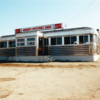9/24/2016 Update: Some corrections to text.
A Cowcatcher on a Diner?
We can imagine that railroad dining cars and diner architecture evolved somewhat similarly as products of the same design eras and the use of common manufacturing materials.
For example, originally, both had long wooden bodies set on wheels. Over time, the wooden bodies were replaced by steel bodies or siding in the case of diners. (Only one entirely steel diner exists.) But, over time, rail cars remained on trucks while diners become increasingly land-bound. OK, but who would have thought that some diners went so far as to include an architectural feature known as a "cowcatcher"?
Post-war examples built by the Mountain View Diners Company (1938-1957) had a stainless steel corner that was called a 'cowcatcher'. Curiously, it projected from the building's corners and not from the side, which would more closely mimic the front of a locomotive. Following is the 1946 O'Rourke's Diner, Middletown, CT taken recently. This diner is a short drive north from Essex, CT home of the Valley Railroad Company. You can follow the excursion train's route and stops on the way to breakfast at the diner. What could be finer? The diner is also just around the block from a Providence and Worcester wye and a great railroad swing bridge -- although who knows what will become of those now that the P&W is being sold?
1946 Mountain View. The cowcatcher is to the right of the brown trash barrel:

Here you can see how far the cowcatcher sticks out from the side of the diner:

Weird right? Over time, the creative and aesthetic use of bent steel inside and outside diner architecture exceeded its use as siding on rail cars. That makes sense: rail car siding, while somewhat decorative, must stand up to the function of a rail car. Additionally, the car's ends, where riders entered and exited or moved between cars, couldn't receive the creative siding treatment that the ends on a diner could, many of which had a center entrance and certainly weren't going to be traveling cross-country at high speeds!
Following are examples of diners that were built by Jerry O'Mahony Inc. (1913-1956) that show how corner steel detailing became more complicated over time. More vertical rather than horizontal elements started appearing in diner buildings in both their siding and roofs -- emphasizing their more sedentary nature and moving a step away from the rail car look and eventually toward the classic '50s look -- much coveted by modelers. Meanwhile, the Mountain View Company stopped using the cowcatcher but introduced their own "Streamliner" model. The connection between rail car and diner apparently was a hard habit to break.
1948 Kelly's Diner horizontal corner detail, Somerville, MA in 2000. No cows will be caught here:

1952-3 Seaplane Diner corner detail -- complicated interleaving pattern, Providence, RI in 2000:

Notice, 'though how similar the siding is to a rail car and with a similar touch of color added. Included in this post are full views of the buildings that show a continuing affinity with the (general) proportions of a rail car.
A final note: If you head north on Rt. 154 to visit the cowcatcher, take a left onto Washington Street in Middletown for a quick side trip. First, you'll be rewarded with a view of a perfectly beautiful small railroad arch bridge -- it's just like my MTH model only 1:1! Second, at 864 Washington Street, you'll find the Athenian Diner II, a more modern interpretation. I ate there because O'Rourke's was closed.
Tomlinson Run Railroad











